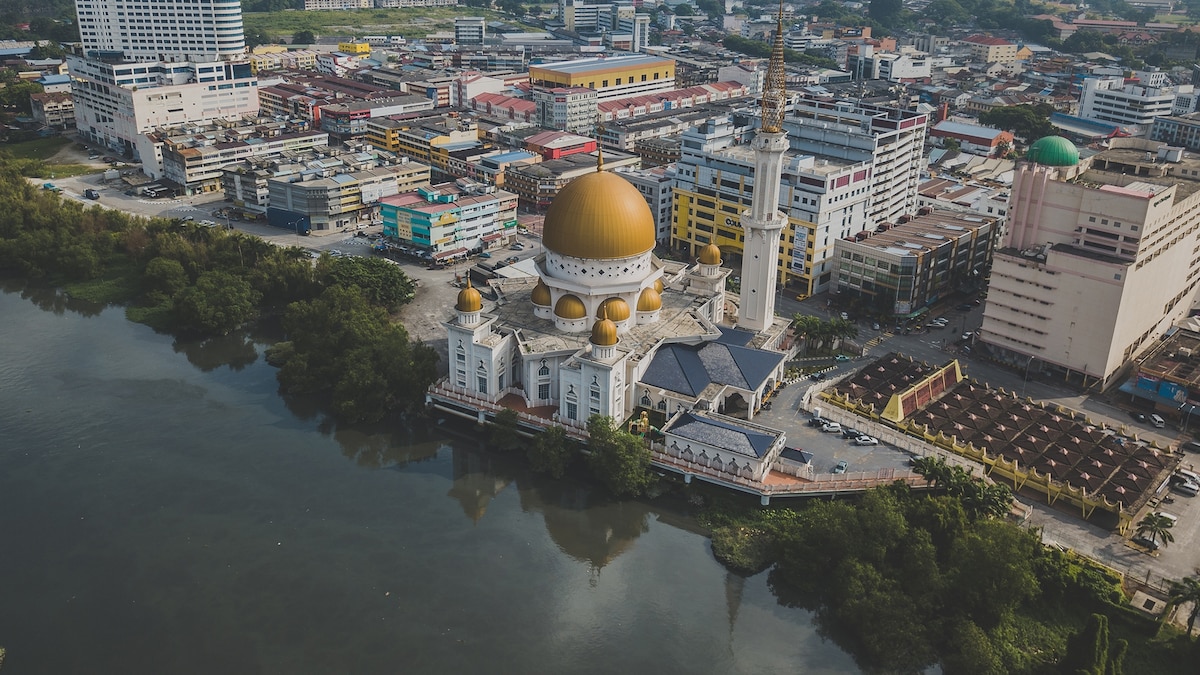Although Kuala Lumpur receives millions of tourists a year, very few take the short taxi ride from the Malaysian mega-capital to the small waterside city of Klang. Here on the Malacca Strait, which separates Malaysia and Indonesia, lies the little known but once fabulously wealthy Selangor Sultanate. Klang is the sultanate’s royal capital, and it’s where visitors will find such hidden treasures as the grand Alam Shah Palace.
(From fiery curries to spicy satays, here’s what to eat in Kuala Lumpur.)
Although visitors can’t enter the palace, which remains the home of Sultan Sharafuddin Idris Shah, ninth ruler of Selangor Sultanate, they can spy its giant gilded dome before joining new walking tours of Klang’s heritage sites. These locations collectively tell the tale of how the Selangor Sultanate came into being in the aftermath of a royal assassination, resisted European invaders, shaped Malay history, and birthed Kuala Lumpur.
What is the Selangor Sultanate?
Selangor has a complex present and past. It continues to be a royal region ruled by a sultan. Yet Selangor is also one of 13 states in Malaysia, which is a constitutional monarchy, like the United Kingdom and Canada, governed by a parliamentary democracy with a king as its head of state. Malaysia’s monarch changes every five years, rotating between the sultans of nine royal families, including Selangor.
The origins of this sultanate, meanwhile, are tied to migration, Dutch intervention, and the murder of a Malay ruler. In the late 1600s, Bugis people from Indonesia began settling in Selangor to escape the Dutch, who’d colonized swathes of Southeast Asia.
Then in 1699 the Malacca Strait’s dominant power, Johor Sultanate, lost its monarch to assassination. With no blood successor to succeed him, Johor’s influence waned and a power vacuum emerged.
“The absence of a centralizing ruler in Johor meant that various ethnic groups that had migrated to the region—Bugis, Minangkabau—had opportunity to develop their own states, often through intermarriage with local Malay elites,” explains Timothy Barnard, associate professor of history at National University of Singapore.
The Bugis steadily grew their influence in the Malacca Strait before creating in 1766 the Selangor Sultanate.
What to do in Klang
Tourists can follow this story at Klang’s impressive Sultan Abdul Aziz Royal Gallery. Housed in an early 1900s colonial building, it is personally curated by Sultan Sharafuddin Idris Shah.
Via paintings, maps, signage, and artifacts, the museum details how Selangor fought military, political, and trade battles with the Dutch, and created a mining area which became Kuala Lumpur. But the sultanate couldn’t withstand the British, who colonized Malaysia for more than a century from 1824.
Tourists can delve deeper into this imperial legacy during new English-language guided walks to 11 key historic sites. The tours will be offered regularly from June 2024.
Tourists can also follow this heritage trail independently, via the map on Visit Selangor’s website. In doing so they’ll view the towering minarets of Tengku Kelana Indian Mosque, the lively market of Little India, the distinctive red-and-white facade of the old Klang Fire Station, and the colonial elegance of the Royal Klang Club.
An Instagram-famous mosque outside Klang
Selangor’s royal tourist trail also extends beyond Klang. In the district of Kuala Langat, 10 miles south of Klang, tourists can admire the landscaped gardens and delicate stonework of Jugra Palace, built in the early 1900s as an official imperial residence.

On the outskirts of Klang, the Sultan Salahuddin Abdul Aziz Mosque draws worshippers and tourists with a 466-foot-tall minaret and dramatic architecture.
Photograph by Annice Lyn, Getty Images
Meanwhile, Selangor’s modern state capital, Shah Alam, showcases royal heritage at its huge Sultan Alam Shah Museum and nearby Shah Alam Royal Mausoleum. Shaped like a traditional Minangkabau house, the former displays almost 4,000 artifacts across five galleries. The latter is a verdant complex where visitors can see the gilt tombs of Selangor royalty.
(What can we learn from Istanbul’s many mosques?)
But Shah Alam’s main tourist draw is a photogenic 1980s building with social media fame. Foreigners flock to Sultan Salahuddin Abdul Aziz Mosque to pose for images before its giant azure dome, 466-foot-tall minarets, and intricate geometric motifs. Many wouldn’t know this magnificent structure is named after the ruler of a sultanate called Selangor.
Tourist crowds are unlikely to descend on Klang anytime soon, no matter how unique the tales revealed by its new walking tours—at least, not while it remains hidden in the ever expanding shadow of skyscraper-laden Kuala Lumpur.
Ronan O’Connell is an Australian journalist and photographer who shuttles between Ireland, Thailand, and Western Australia.





